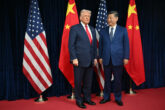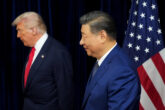January 20, 2025
The Trump-Biden-Trump Foreign Policy
Today, U.S. President Donald Trump will sweep back into power promising a new American approach to the world. As he was in 2017, Trump has been harshly critical of his predecessor’s foreign policy and pledged major differences in priorities and style. His supporters cheer the return to an “America first” attitude, one that emphasizes toughness, seeks concrete benefits from any foreign engagements, and centers on hardheaded dealmaking. His detractors fear a cramped, short-term worldview combined with an erratic, transactional approach to a complicated international environment. Either way, much of the world now braces for significant policy departures and prepares for a major lurch in U.S. foreign policy.
To be sure, a second Trump era promises significant changes after four years of President Joe Biden’s administration. Biden firmly committed to supporting Ukraine, defending Taiwan militarily, fulfilling the United States’ climate change commitments, and centering democracy in U.S. foreign policy. He stressed the benefits of the United States’ alliances and the threats that China and other revisionist powers pose to the global order. Trump, on the other hand, questions the need to continue aiding Ukraine, declines to commit to Taiwan’s protection, downplays climate change, and deprioritizes the promotion of democracy and human rights. He often portrays U.S. allies as free riders enriching themselves under U.S. protection and emphasizes the unfairness of trade deficits with countries such as China more than any systemic risks these countries might pose. The new president will surely spend his first weeks in office issuing executive orders and other directives aimed at visibly reversing Biden’s policies.
The stability of U.S. interests and values, the role of Congress, and the realities of today’s world will demand a significant measure of constancy.
For all the differences, however, there will likely be far more continuity between the two administrations than meets the eye. Across administrations—even ones as different as those of Biden and Trump—foreign policy is something like an iceberg. The visible portion is gleaming and jagged and draws much of the attention. Yet it also has a far bigger and underexamined foundation, one that tends to remain mostly unchanged. Even as they focus on Trump’s differences in style and substance, observers should not ignore the potential stability in the United States’ approach to the world. Otherwise, they may misunderstand policy, attributing it to a specific president, rather than more firmly rooted in bipartisan consensus and likely to endure.
Read the full article on Foreign Affairs.
More from CNAS
-
Chinese Maker of Bitcoin-Mining Machines Is a Security Threat, Says Expert
Bloomberg News reports that a Chinese manufacturer, Bitmain Technologies Ltd, that sells most of the world’s Bitcoin-mining machines — including 16,000 of them to a venture ba...
By David Feith
-
Indo-Pacific Security / Energy, Economics & Security
North Korea’s Provocations, Power Plays, and Shifting AlliancesTensions on the Korean Peninsula have reached a new and dangerous threshold. President Lee Jae Myung is warning of a real risk of accidental military clashes, as the situation...
By Dr. Go Myong-Hyun
-
Indo-Pacific Security / Energy, Economics & Security
How to Win the Economic War with ChinaTrump's approach to China has run aground, giving Beijing unprecedented advantage in the economic conflict....
By Edward Fishman & Julian Gewirtz
-
Indo-Pacific Security / Technology & National Security
Sharper: Tech + ChinaRecent talks between President Donald Trump and Chinese Communist Party General Secretary Xi Jinping placed a spotlight on emerging technologies, from high-end chips to minera...
By Charles Horn & Sevi Silvia




